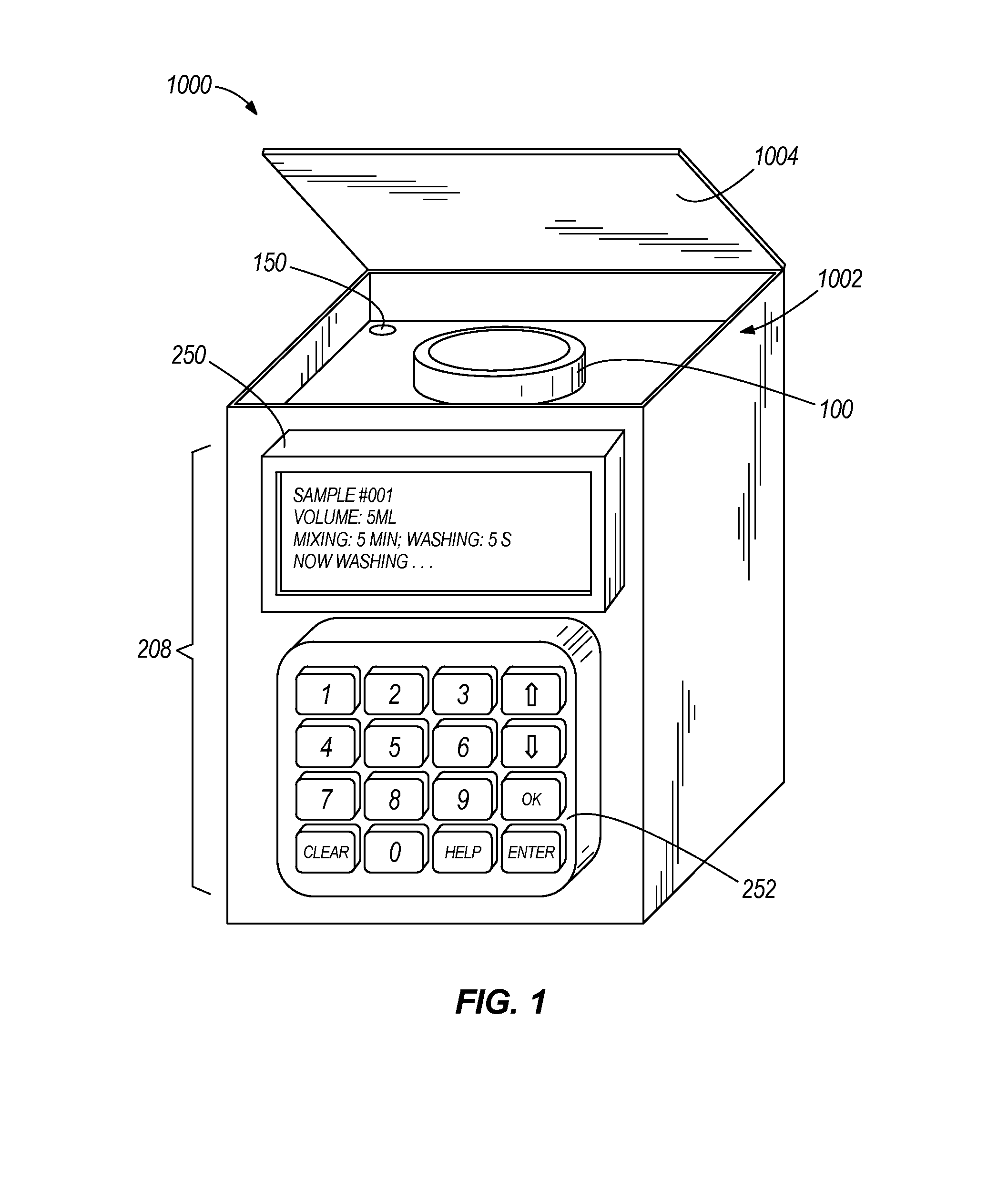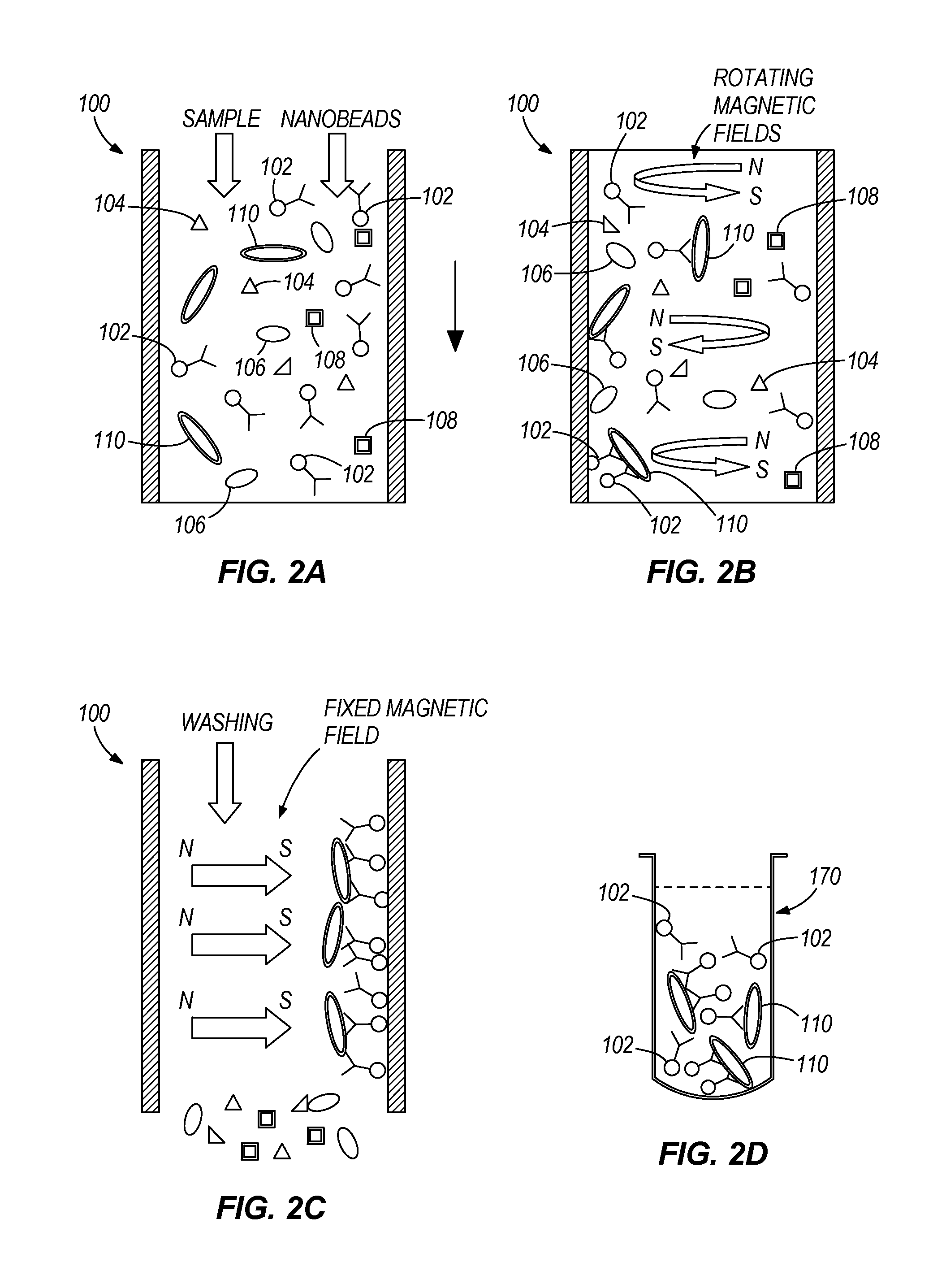Separation system and efficient capture of contaminants using magnetic nanoparticles
a magnetic nanoparticle and separation system technology, applied in the field of separation system and efficient capture of contaminants using magnetic nanoparticles, can solve the problems of requiring 18 or more hours, difficult detection of contaminants, and generally time-consuming, and achieves high efficiency and capture rate. , the effect of short operation tim
- Summary
- Abstract
- Description
- Claims
- Application Information
AI Technical Summary
Benefits of technology
Problems solved by technology
Method used
Image
Examples
example 1
Capture of E. coli with Magnetic Nanoparticles
[0057]Culture and plating of bacteria. Frozen stocks of E. coli O157:H7 (ATCC 43888), Rifampicin resistant E. coli O157:H7 (ATCC 43888), S. enteritidis (ATCC 13076), L. monocytogenes (FDA 101M 4b), and Citrobacter freundii (ATCC 3624) were maintained in Brain Heart Infusion (BHI, with 12% glycerol) broth (Remel Inc., Lenexa, Kans.) at −70° C. All cultures were harvested in BHI broth maintained at 37° C. for 18-22 h. Pure cultures were diluted with 0.01 M, pH 7.4 phosphate-buffered saline (PBS). E. coli O157:H7 was surface plated on sorbitol MacConkey (SMAC) agar (Remel Inc., Lenexa, Kans.), which was incubated at 37° C. for 20-22 h. Rifampicin resistant E. coli O157:H7 was surface plated on the SMAC agar with 0.3% (wt / vol) rifampicin (Sigma Chemicals Co., St. Louis, Mo.).
[0058]Chemicals and reagents. PBS (0.01 M, pH 7.4) was obtained from Sigma-Aldrich (St. Louis, Mo.). Bovine serum albumin (BSA, EM Science, Gibbstown, N.J.), 0.5% (wt / vo...
example 2
Comparison of Magnetic Nanoparticle-Antibody Conjugates with Immunomagnetic Microbeads
[0074]For comparison, magnetic microbeads (MMBs) were used in parallel with MNCs, following the same procedure. For MMBs, the immunoreaction was carried out by mixing 10 μL of MMBs with 0.5 mL of a sample containing E. coli O157:H7 at a given cell concentration by rotating at 10 RPM with a variable speed rotator.
[0075]MNCs resulted in significantly higher capacity (CE values) to separate E. coli O157:H7 as compared to MMBs for all combinations of three levels of cell numbers with four immunoreaction times. FIG. 11a shows CEs of both MNCs and MMBs for detection of E. coli O157:H7 at 3 concentrations (103, 105, 107 CFU / 0.5 mL) with an immunoreaction time of 30 min. MMBs showed a decrease in CE with an increase in concentration of bacteria. CEs of MMBs were 92%, 90%, and 83% for 3.6×103, 4.2×105, and 3.5×107 CFU / 0.5 mL of E. coli O157:H7, respectively. MNCs showed CEs of 98%, 98%, and 97% for 3.6×103,...
example 3
Detection of E. coli in Ground Beef
[0078]Food sample preparation and enrichment. Commercial ground beef was purchased from a local supermarket. Two types of samples were prepared for ground beef: one with enrichment for low cell concentrations (100 and 101 CFU / mL) in tryptic soy broth (TSB, EM Science, Gibbstown, N.J.), and the other without enrichment for higher concentrations (103 to 107 CFU / mL) in buffered peptone water (BPW, Remel Inc., Lexena, Kans.). For both cases, 25 grams of ground beef was homogenized with 225 mL of 0.1% BPW or TSB in a Whirl-pak plastic bag using a laboratory stomacher 400 (Seward, UK) for 2 min. After stomaching, food samples were inoculated with decimally diluted cultures of E. coli O157:H7. For enrichment, 1 mL of 8×101 CFU / mL and 4×102 CFU / mL of E. coli O157:H7 was added to 9 mL of TSB homogenized ground beef samples, and incubated at 37° C. for 6 h. For samples without enrichment, 1 mL of E. coli O157:H7 ranging from 6.0×104 CFU / mL to 3.4×108 CFU / mL ...
PUM
| Property | Measurement | Unit |
|---|---|---|
| size | aaaaa | aaaaa |
| pH | aaaaa | aaaaa |
| pH | aaaaa | aaaaa |
Abstract
Description
Claims
Application Information
 Login to View More
Login to View More - R&D
- Intellectual Property
- Life Sciences
- Materials
- Tech Scout
- Unparalleled Data Quality
- Higher Quality Content
- 60% Fewer Hallucinations
Browse by: Latest US Patents, China's latest patents, Technical Efficacy Thesaurus, Application Domain, Technology Topic, Popular Technical Reports.
© 2025 PatSnap. All rights reserved.Legal|Privacy policy|Modern Slavery Act Transparency Statement|Sitemap|About US| Contact US: help@patsnap.com



